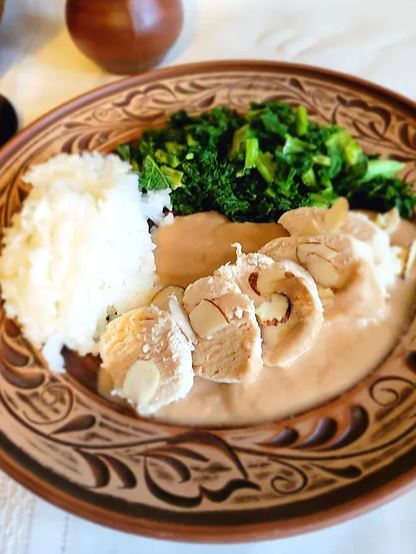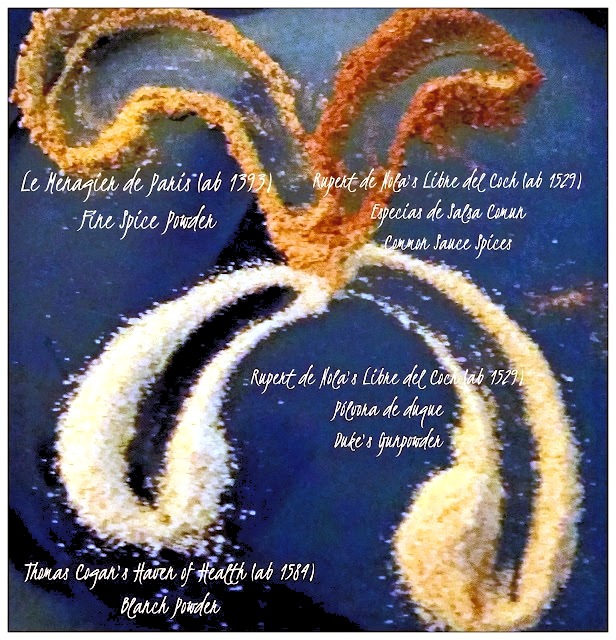The Roman historian Pliny writes about "fish-glue", a process that produced a thin, honey like substance that when mixed with other items could be used to remove wrinkles and plump the skin. The instructions he gives bear a closer resemblence to the instructions to make Gelye of Fleysshe.
Fish-glue effaces wrinkles and plumps out the skin; being boiled for the purpose in water some four hours, and then pounded and kneaded up till it attains a thin consistency, like that of honey. -- The Natural History of Pliny, Volume 6 of 6, by Pliny the Elder
The earliest recipes I was able to locate for making gelye dishes come from the 1300's. The first being for fish from Enseignements qui enseingnent a apareillier toutes manieres de viandes (1300's).
If you want to make fish jelly, break the back of the fish and cut it into pieces, that is to say: carp and tench, bream and turbot, and put to cook in good, strong wine; Then take cinnamon, ginger, long pepper, galingale, lavender and a little saffron; Then grind and put all together; And when you strain it of the fire, then in take out the fish in a bowl and pour thereon; and if you see that it is too thick, then sieve it and let it cool until the morning, and by then take it likewise like jelly.
The second from 1381 for a meat jelly from MS Douce 257
For to make mete gelee þat it be wel chariaunt, tak wyte wyn & a perty of water & safroun & gode spicis & flesch of piggys or of hennys, or fresch fisch, & boyle þam togedere; & after, wan yt ys boylyd & cold, | dres yt in dischis & serue yt forþe.
.Cix. Gelye de chare.—Take caluys fete, & skalde hem in fayre water, an make hem alle þe whyte. Also take howhys of [leaf 20.] Vele, & ley hem on water to soke out þe blode; þen take hem vppe, an lay hem on a fayre lynen cloþe, & lat þe water rennyn out of hem [supplied by ed.] ; þan Skore*. [Scour. ] a potte, & putte þe Fete & þe Howhys þer-on; þan take Whyte Wyne þat wolle hold coloure, & cast þer-to a porcyon, an non oþer lycoure, þat þe Fleysshe be ouer-wewyd*. [See other Cookery, No. 174, wese. ] withalle, & sette it on þe fyre, & boyle it, & Skeme it clene; an whan it is tendyr & boylid y-now, take vppe þe Fleyshe in-to a fayre bolle, & saue þe lycoure wyl; & loke þat þow haue fayre sydys of Pyggys, & fayre smal Chykenys wyl & clene skladdyd & drawe, & lat þe leggys an þe fete on, an waysshe hem in fayre water, & caste hem in þe fyrste brothe, an sethe it a-ȝen ouer þe fyre, & skeme it clene; lat a man euermore kepe it, an blow of þe grauy. An in cas þe lycoure wast*. [Waste. ] a-way, caste more of þe same wyne þer-to, & put þin honde þer-on; & ȝif þin hond waxe clammy, it is a syne of godenesse, an let not þe Fleyshe be moche sothe,*. [boiled. ] þat it may bere kyttyng; þan take it vppe, & ley it on a fayre cloþe, & sette owt þe lycoure fro þe fyre, & put a few colys vnder-nethe þe vesselle þat þe lycoure is yn; þan take pouder of Pepir, a gode quantyte, & Safron, þat it haue a fayre Laumbere coloure, & a gode quantyte of Vynegre, & loke þat it be sauery of [supplied by ed.] Salt & of Vynegre, fayre of coloure of Safroun, & putte it on fayre lynen cloþe, & sette it vndernethe a fayre pewter dysshe, & lat it renne þorw þe cloþe so ofte tylle it renne clere: kytte fayre Rybbys of þe syde of þe Pygge, & lay ham on a dysshe, an pulle of þe lemys of þe Chykenys, eche fro oþer, & do a-way þe Skynne, & ley sum in a dysshe fayre y-chowchyd,*. [Y-couched; laid. ] & pore þin*. [Thine. ] gelye þer-on, & lay Almaundys þer-on, an Clowys, & paryd Gyngere, & serue forth.
109. Gely of Flesh - Take calves feet, and scald them in fair water, and make them all the white. Also take hooves of veal, and lay them on water to soak out the blood; then take them up and lay them on a fair linen cloth, and let the water running out of them; then scour a pot and put the feet and hooves there-on; then take white wine that would hold color, and caste there-to a portion and none other liquor, that the flesh be over-washed withal, and set it on the fire and boil it and skim it clean; and when it is tender and boiled enough, take up the flesh into a fair bowl, and save the liquor well; and look that you have fair sides of pigs, and fair small chickens well and clean scalded and draw, and let the legs and the feet on, and wash them in fair water, and caste them in the first broth, and boil it again over the fire, and skim it clean; let a man evermore keep it, and blow off the gravy. And in case the liquor waist away, caste more of the same wine thereto, and put your hand there-on and if your hand wax clammy, it is a sign of goodness, and let no the flesh be much boiled that it may bear cutting; then take it up and lay it on a fair cloth and set out the liquor from the fire, and put a few cloths underneath the vessel that the liquor is in; then take good powder of pepper, a good quantity of saffron, that it have a fair amber color, and a good quantity of vinegar, and look that it be savory of salt and of vinegar, fair of color of saffron, & put it on fair linen cloth, & set it underneath a fair pewter dish, and let it run through the cloth so oft till it run clear: cut fair ribs of the side of the pig, and lay them on a dish, and pull of the limbs (?) of the chickens, each from the other, and do away the skin, and lay some in a dish fair y-couched (laid) and pour your gely thereon, and lay almonds, thereon and cloves and paired ginger, and serve forth.
.Cx. Gelye de Fysshe.—Take newe Pykys, an draw hem, and smyte hem to pecys, & sethe in þe same lycoure þat þou doste Gelye of Fleysshe; an whan þey ben y-now, take Perchys and Tenchys, & seþe; & Elys, an kutte hem in fayre pecys, and waysshe hem, & putte hem in þe same lycoure, & loke þine lycoure be styf y-now; & ȝif it wolle notte cacche,*. [stick; see other Cookery, No. 174. ] take Soundys of watteryd Stokkefysshe, or ellys Skynnys, or Plays, an caste þer-to, & sethe ouer þe fyre, & skeme it wyl; & when it ys y-now, let nowt þe Fysshe breke; þenne take þe lycoure fro þe fyre, & do as þou dedyst be*. [By, with. ] þat oþer Gelye, saue, pylle þe Fysshe, & ley þer-off in dysshis, þat is, perche & suche; and Flowre hem, & serue forthe.
110. Gely of Fish --Take new pike, and draw them, and smite them into pieces, and boil in the same liquor that you do gely of flesh; and when they been enough, take perch and tench, and cook, and eels, and cut them in fair pieces and wash them, and put them in the same liquor, and look your liquor be stiff enough, and if it would not catch (stick?), take sounds (swim bladder) of watery stockfish, or eel skins or plaice, and caste thereto, and cook, and cook over the fire and skim it well; and when it is enough, let not the flesh break; then take the liquor from the fire, and do as you did with the other gely, save pile the fish, and lay there-of in dishes that is, perch and such; and flower them and serve forth.


